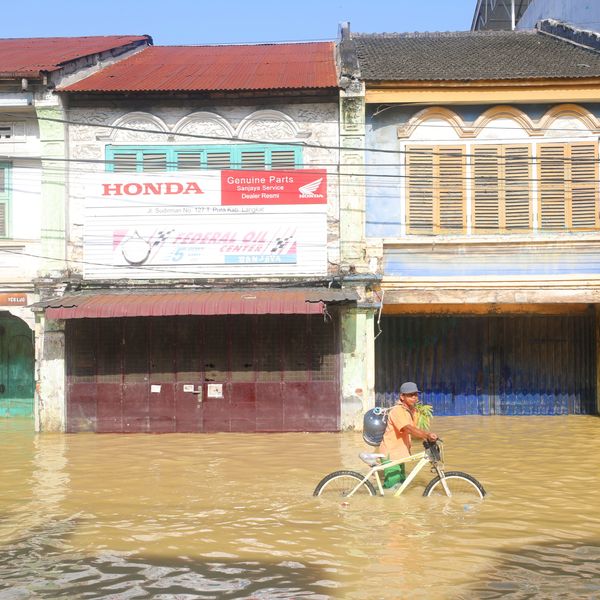
An aerial picture taken on August 24, 2022 shows the riverbed of the Jialing River, a tributary of the Yangtze River, in China's southwestern city of Chongqing.
Oxford Study Warns Extreme Heat and Drought to Hit 90% of World Population
The frequency of compound drought-heatwave events is "projected to increase by tenfold globally under the highest emissions scenario."
As interlinked extreme heat and drought events grow in intensity and frequency amid the ruling class' ongoing failure to adequately slash planet-heating fossil fuel pollution, over 90% of the global population is projected to suffer the consequences in the coming decades, according to peer-reviewed research published Thursday in Nature Sustainability.
Compound drought-heatwave (CDHW) events are "one of the worst climatic stressors for global sustainable development," states the paper, but their "physical mechanisms" and "impacts on socio-ecosystem productivity remain poorly understood."
"Using simulations from a large climate-hydrology model," nine scholars—working at universities in China, the United States, the United Kingdom, and Japan—found that "the frequency of extreme CDHWs is projected to increase by tenfold globally under the highest emissions scenario, along with a disproportionate negative impact on vegetation and socio-economic productivity by the late 21st century."
According to the study: "Terrestrial water storage and temperature are negatively coupled, probably driven by similar atmospheric conditions (for example, water vapor deficit and energy demand). Limits on water availability are likely to play a more important role in constraining the terrestrial carbon sink than temperature extremes."
Put plainly, drought and extreme heat are intertwined. Increasingly arid and hot conditions are undermining the capacity of land-based ecosystems to absorb carbon dioxide, with a lack of water considered even more consequential than higher temperatures.
Not only are CDHWs hurting the ability of biodiverse regions to absorb a key greenhouse gas but these increasingly intense and frequent events also threaten to exacerbate socioeconomic inequalities.
The study estimates that even under the lowest emission scenario, "over 90% of the global population and gross domestic product could be exposed to increasing CDHW risks in the future, with more severe impacts in poorer and more rural areas."
\u201cOur new paper on global compound hazards has been published on Nature Sustainability today (https://t.co/v9CXNnNEPl). Thank our contributors @PierreGentine @DrLouiseSlater @LeiguSs @PokhrelYadu @NaotaHanasaki @WolframSchlenker\u201d— Jiabo Yin (@Jiabo Yin) 1672944002
Lead author Jiabo Yin, an associate professor of hydrology at Wuhan University and visiting researcher at Oxford University, explained in a statement that quantifying "the response of ecosystem productivity to heat and water stressors at the global scale" shows that the joint threats of dangerously hot temperatures and drought pose substantially greater risks to society and the environment when assessed together rather than independently.
The effects of rising temperatures and declining terrestrial water storage combine to weaken the capacity of "carbon sinks" to absorb heat-trapping emissions and release oxygen, Yin noted.
Co-author Lousie Slater, associate professor of physical geography at the University of Oxford, said that "understanding compounding hazards in a warming Earth is essential for the implementation of the U.N. Sustainable Development Goals (SDGs), in particular SDG13 that aims to combat climate change and its impacts."
"By combining atmospheric dynamics and hydrology, we explore the role of water and energy budgets in causing these extremes," said Slater.
The new research, which is aimed at "assessing and mitigating adverse effects of compound hazards on ecosystems and human well-being," comes in the wake of record-breaking extreme heat and historic droughts around the world in 2022.
The life-threatening impacts of the global climate emergency have only continued to reverberate in 2023, underscoring the need to expedite the clean energy transition, among other necessary transformations.
An Urgent Message From Our Co-Founder
Dear Common Dreams reader, The U.S. is on a fast track to authoritarianism like nothing I've ever seen. Meanwhile, corporate news outlets are utterly capitulating to Trump, twisting their coverage to avoid drawing his ire while lining up to stuff cash in his pockets. That's why I believe that Common Dreams is doing the best and most consequential reporting that we've ever done. Our small but mighty team is a progressive reporting powerhouse, covering the news every day that the corporate media never will. Our mission has always been simple: To inform. To inspire. And to ignite change for the common good. Now here's the key piece that I want all our readers to understand: None of this would be possible without your financial support. That's not just some fundraising cliche. It's the absolute and literal truth. We don't accept corporate advertising and never will. We don't have a paywall because we don't think people should be blocked from critical news based on their ability to pay. Everything we do is funded by the donations of readers like you. Will you donate now to help power the nonprofit, independent reporting of Common Dreams? Thank you for being a vital member of our community. Together, we can keep independent journalism alive when it’s needed most. - Craig Brown, Co-founder |
As interlinked extreme heat and drought events grow in intensity and frequency amid the ruling class' ongoing failure to adequately slash planet-heating fossil fuel pollution, over 90% of the global population is projected to suffer the consequences in the coming decades, according to peer-reviewed research published Thursday in Nature Sustainability.
Compound drought-heatwave (CDHW) events are "one of the worst climatic stressors for global sustainable development," states the paper, but their "physical mechanisms" and "impacts on socio-ecosystem productivity remain poorly understood."
"Using simulations from a large climate-hydrology model," nine scholars—working at universities in China, the United States, the United Kingdom, and Japan—found that "the frequency of extreme CDHWs is projected to increase by tenfold globally under the highest emissions scenario, along with a disproportionate negative impact on vegetation and socio-economic productivity by the late 21st century."
According to the study: "Terrestrial water storage and temperature are negatively coupled, probably driven by similar atmospheric conditions (for example, water vapor deficit and energy demand). Limits on water availability are likely to play a more important role in constraining the terrestrial carbon sink than temperature extremes."
Put plainly, drought and extreme heat are intertwined. Increasingly arid and hot conditions are undermining the capacity of land-based ecosystems to absorb carbon dioxide, with a lack of water considered even more consequential than higher temperatures.
Not only are CDHWs hurting the ability of biodiverse regions to absorb a key greenhouse gas but these increasingly intense and frequent events also threaten to exacerbate socioeconomic inequalities.
The study estimates that even under the lowest emission scenario, "over 90% of the global population and gross domestic product could be exposed to increasing CDHW risks in the future, with more severe impacts in poorer and more rural areas."
\u201cOur new paper on global compound hazards has been published on Nature Sustainability today (https://t.co/v9CXNnNEPl). Thank our contributors @PierreGentine @DrLouiseSlater @LeiguSs @PokhrelYadu @NaotaHanasaki @WolframSchlenker\u201d— Jiabo Yin (@Jiabo Yin) 1672944002
Lead author Jiabo Yin, an associate professor of hydrology at Wuhan University and visiting researcher at Oxford University, explained in a statement that quantifying "the response of ecosystem productivity to heat and water stressors at the global scale" shows that the joint threats of dangerously hot temperatures and drought pose substantially greater risks to society and the environment when assessed together rather than independently.
The effects of rising temperatures and declining terrestrial water storage combine to weaken the capacity of "carbon sinks" to absorb heat-trapping emissions and release oxygen, Yin noted.
Co-author Lousie Slater, associate professor of physical geography at the University of Oxford, said that "understanding compounding hazards in a warming Earth is essential for the implementation of the U.N. Sustainable Development Goals (SDGs), in particular SDG13 that aims to combat climate change and its impacts."
"By combining atmospheric dynamics and hydrology, we explore the role of water and energy budgets in causing these extremes," said Slater.
The new research, which is aimed at "assessing and mitigating adverse effects of compound hazards on ecosystems and human well-being," comes in the wake of record-breaking extreme heat and historic droughts around the world in 2022.
The life-threatening impacts of the global climate emergency have only continued to reverberate in 2023, underscoring the need to expedite the clean energy transition, among other necessary transformations.
- Over 1,000 Die as Record-Breaking Heat, Wildfires Scorch Europe ›
- Healthy Human Future Still Possible If World Ditches Fossil Fuels: Lancet Study ›
- 'Absolute Madness': Record-Shattering Heat Dome Hits Europe ›
- Extreme Heat, Droughts in China and Europe Signal Global Climate Emergency ›
As interlinked extreme heat and drought events grow in intensity and frequency amid the ruling class' ongoing failure to adequately slash planet-heating fossil fuel pollution, over 90% of the global population is projected to suffer the consequences in the coming decades, according to peer-reviewed research published Thursday in Nature Sustainability.
Compound drought-heatwave (CDHW) events are "one of the worst climatic stressors for global sustainable development," states the paper, but their "physical mechanisms" and "impacts on socio-ecosystem productivity remain poorly understood."
"Using simulations from a large climate-hydrology model," nine scholars—working at universities in China, the United States, the United Kingdom, and Japan—found that "the frequency of extreme CDHWs is projected to increase by tenfold globally under the highest emissions scenario, along with a disproportionate negative impact on vegetation and socio-economic productivity by the late 21st century."
According to the study: "Terrestrial water storage and temperature are negatively coupled, probably driven by similar atmospheric conditions (for example, water vapor deficit and energy demand). Limits on water availability are likely to play a more important role in constraining the terrestrial carbon sink than temperature extremes."
Put plainly, drought and extreme heat are intertwined. Increasingly arid and hot conditions are undermining the capacity of land-based ecosystems to absorb carbon dioxide, with a lack of water considered even more consequential than higher temperatures.
Not only are CDHWs hurting the ability of biodiverse regions to absorb a key greenhouse gas but these increasingly intense and frequent events also threaten to exacerbate socioeconomic inequalities.
The study estimates that even under the lowest emission scenario, "over 90% of the global population and gross domestic product could be exposed to increasing CDHW risks in the future, with more severe impacts in poorer and more rural areas."
\u201cOur new paper on global compound hazards has been published on Nature Sustainability today (https://t.co/v9CXNnNEPl). Thank our contributors @PierreGentine @DrLouiseSlater @LeiguSs @PokhrelYadu @NaotaHanasaki @WolframSchlenker\u201d— Jiabo Yin (@Jiabo Yin) 1672944002
Lead author Jiabo Yin, an associate professor of hydrology at Wuhan University and visiting researcher at Oxford University, explained in a statement that quantifying "the response of ecosystem productivity to heat and water stressors at the global scale" shows that the joint threats of dangerously hot temperatures and drought pose substantially greater risks to society and the environment when assessed together rather than independently.
The effects of rising temperatures and declining terrestrial water storage combine to weaken the capacity of "carbon sinks" to absorb heat-trapping emissions and release oxygen, Yin noted.
Co-author Lousie Slater, associate professor of physical geography at the University of Oxford, said that "understanding compounding hazards in a warming Earth is essential for the implementation of the U.N. Sustainable Development Goals (SDGs), in particular SDG13 that aims to combat climate change and its impacts."
"By combining atmospheric dynamics and hydrology, we explore the role of water and energy budgets in causing these extremes," said Slater.
The new research, which is aimed at "assessing and mitigating adverse effects of compound hazards on ecosystems and human well-being," comes in the wake of record-breaking extreme heat and historic droughts around the world in 2022.
The life-threatening impacts of the global climate emergency have only continued to reverberate in 2023, underscoring the need to expedite the clean energy transition, among other necessary transformations.
- Over 1,000 Die as Record-Breaking Heat, Wildfires Scorch Europe ›
- Healthy Human Future Still Possible If World Ditches Fossil Fuels: Lancet Study ›
- 'Absolute Madness': Record-Shattering Heat Dome Hits Europe ›
- Extreme Heat, Droughts in China and Europe Signal Global Climate Emergency ›

